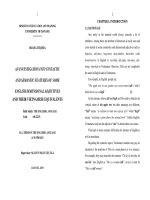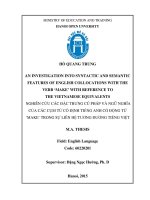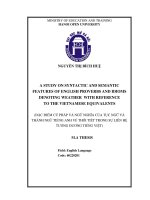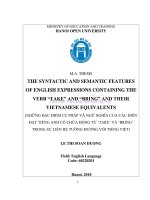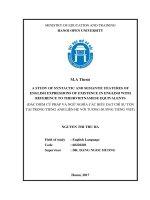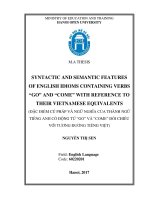An investigation into syntactic and semantic features of english collocations with the verb make with reference to the vietnamese equivalents
Bạn đang xem bản rút gọn của tài liệu. Xem và tải ngay bản đầy đủ của tài liệu tại đây (1.22 MB, 83 trang )
MINISTRY OF EDUCATION AND TRAINING
HANOI OPEN UNVERSITY
HỒ QUANG TRUNG
AN INVESTIGATION INTO SYNTACTIC AND SEMANTIC
FEATURES OF ENGLISH COLLOCATIONS WITH THE
VERB ‘MAKE’ WITH REFERENCE TO
THE VIETNAMESE EQUIVALENTS
NGHIÊN CỨU CÁC ĐẶC TRƯNG CÚ PHÁP VÀ NGỮ NGHĨA
CỦA CÁC CỤM TỪ CỐ ĐỊNH TIẾNG ANH CÓ ĐỘNG TỪ
‘MAKE’ TRONG SỰ LIÊN HỆ TƯƠNG ĐƯƠNG TIẾNG VIỆT
M.A. THESIS
Field: English Language
Code: 60220201
Supervisor: Đặng Ngọc Hướng, Ph. D
Hanoi, 2015
MINISTRY OF EDUCATION AND TRAINING
HANOI OPEN UNVERSITY
HỒ QUANG TRUNG
AN INVESTIGATION INTO SYNTACTIC AND SEMANTIC
FEATURES OF ENGLISH COLLOCATIONS WITH THE
VERB ‘MAKE’ WITH REFERENCE TO
THE VIETNAMESE EQUIVALENTS
NGHIÊN CỨU CÁC ĐẶC TRƯNG CÚ PHÁP VÀ NGỮ NGHĨA
CỦA CÁC CỤM TỪ CỐ ĐỊNH TIẾNG ANH CÓ ĐỘNG TỪ
‘MAKE’ TRONG SỰ LIÊN HỆ TƯƠNG ĐƯƠNG TIẾNG VIỆT
M.A. THESIS
Field: English Language
Code: 60220201
Supervisor: Đặng Ngọc Hướng, Ph. D
Hanoi, 2015
CERTIFICATE OF ORIGINALITY
I, the undersigned, hereby certify my authority of the study project report
entitled An Investigation into Syntactic and Semantic Features of English
Collocations with the verb MAKE with reference to the Vietnamese
Equivalentssubmitted in partial fulfillment of the requirements for the degree
of Master in English Language. Except where the reference is indicated, no
other person’s work has been used without due acknowledgement in the text of
the thesis.
Hanoi, 2016
Hồ Quang Trung
Approved by
SUPERVISOR
Đặng Ngọc Hướng, Ph. D
i
Date:……………………
ACKNOWLEDGEMENTS
This thesis could not have been completed without the help and support
from a number of people.
First of all, I’d like to express my sincere appreciation to my supervisor,
Đặng Ngọc Hướng Ph. D, who has patiently supported me through the stages
of the study, and whose stimulating ideas, expertise, and suggestions have
inspired me greatly through my growth as an academic researcher.
A special word of thanks goes to many other lecturers, without whose
support and encouragement it would never have been possible for me to have
this thesis accomplished.
Last but not least, I am greatly indebted to my family, my lover for the
sacrifice they have devoted to the fulfillment of this academic work.
ii
ABSTRACT
Among the most popular English words being used currently worldwide,
the verb MAKE has been without a doubt given great attention by linguists so
far. Therefore, an initial investigation intosyntactic and semantic features of
English collocations with the verb MAKE with reference to the Vietnamese
equivalents would provide valuable experience to further studies of linguistics
in general and teaching them for studentsat the University of Labor and Social
Affairs in particular. Numerous examples have been analyzed cautiously by
applying qualitative approach and some other ones so as to achieve the set
objectives.
iii
LIST OF TABLES AND FIGURES
Table 2.1. Examples of Lexical Collocations of Hill (2000)
28
Table 2.2. A List of Types of Verbs
29
Table 2.3. Verb Patterns of the Verb MAKE
31
Table 2.4. Other Structures of MAKE + Noun
32
iv
TABLE OF CONTENTS
Certificate of Originality
i
Acknowledgements
ii
Abstract
iii
List of Tables and Figures
iv
Chapter 1: INTRODUCTION
1
1.1.
Rationale for the Research
1
1.2.
Aims of the Research
2
1.3.
Objectives of the Research
2
1.4.
Scope of the Research
2
1.5.
Significance of the Research
4
1.6.
Structural Organization of the Thesis
5
Chapter 2: LITERATURE REVIEW
7
2.1.
Review of Previous Studies
7
2.2.
Review of Theoretical Background
10
2.3.
Summary
28
Chapter 3: METHODOLOGY
29
3.1.
29
Research-governing Orientations
3.1.1. Research Questions
29
3.1.2. Research Setting
30
3.1.3. Research Approaches
30
3.1.4. Principles for Intended Data Collection and Data Analysis
31
3.2.
32
Research Methods
v
3.2.1. Major Methods vs. Supporting Methods
32
3.2.2. Data Collection Instruments
32
3.2.3. Data Analysis Techniques
33
3.3.
33
Summary
Chapter 4: FINDINGS AND DISCUSSION
34
4.1.
34
Syntactic Features of English Collocations with the verb MAKE
with reference to the Vietnamese equivalents
4.2.
Semantic Features of English Collocations with the verb MAKE
41
with reference to the Vietnamese equivalents
4.3.
Implications for teaching English collocations with the verb
52
MAKE
Chapter 5: CONCLUSION
56
5.1.
Recapitulation
56
5.2.
Concluding remarks
56
5.3.
Limitation of the research
57
5.4.
Suggestions for further studies
58
REFERENCES
59
APPENDICES
62
vi
Chapter 1
INTRODUCTION
1.1. Rationale for the Research
It is obviously accepted that language is an indispensable part in the life
of humanity. Being considered as a significant means to acquire interpersonal
communication and to perform ordinary feelings, this human being’s ability
engages in every single human activity.
Through the history of the development of English, various words which
are considered most common have been created and given great attention from
linguists. In English, there has been a list of around 1,000 most popular words
of all parts of speech that can be used on a daily basis for learners of English to
comprehend. In addition, Oxford Dictionary and some other academic sources
have also managed to conduct a study of 100 most usedEnglish words out of a
billion words found worldwide.
Among the above-mentioned 100 lemmas that make up for more than
50% of the dictionary of Oxford, the verb MAKE is officially ranked 52th. The
investigation in both syntactic and semantic features of its English collocations
is undoubtedly able to capture special attention of all-time linguists.
By studying cautiously into a minor aspect of linguistics with a certain
verb as MAKE, the author confidently hopes that this studywould
1
effectivelyprovide experience to further studies of linguistics in general as well
asEnglish collocations of the verb MAKE and those of other verbs
in
particular. What’s more, analysis of their equivalents in Vietnamese would also
be drawn in order to comprehend and make use of them more effectively.
1.2. Aims of the Research
This research is conducted to achieve the targets of finding out syntactic
and semantic features of English collocations with the verb MAKE with
reference to the Vietnamese equivalents as well as suggesting some possible
implications for teaching them to students at the University of Labor and Social
Affairs who study English as a foreign language.
1.3. Objectives of the research
To achieve the above-mentioned aims, the following objectives can be
put forward:
(i) Pointing outsyntacticfeatures of English collocations of the verb
MAKE with reference to the Vietnamese equivalents.
(ii) Figuring out semantic features of English collocations of the verb
MAKE with reference to the Vietnamese equivalents.
(iii) Suggesting possible implications for teaching English collocations of
the verb MAKE
1.4. Scope of the Research
(i) Academic Scope
The study focuses on studying syntactic and semantic features of English
collocations with the verb MAKE and theequivalents in Vietnamese so as to
make crucial contributions to the field of linguistics and improve the efficiency
2
of teaching English collocations with the verb MAKE for non-English majored
students at the University of Labor and Social Affairs. The findings hopefully
would bring out various suggestions for teachers and researchers to conduct
further studies related to English collocations with the verb MAKE itself and
those of other verbs as well as advance teaching effectiveness of
collocations.Such approach definitely helps students efficiently expand their
lexical items as students are exposed to a new look at how words are frequently
used in reality, not purely words’ definitions without notes for practical ways
of using them. It is better if English collocations with more verbs are analyzed
and totalized, contributing considerably to English learning and teaching in
Vietnam.
(ii) Social Scope
The applications of this work will, hopefully, contribute greatly to find
out appropriate methodsto teaching English collocations in Vietnam and make
changes to how Vietnamese learners of English view English collocations not
only in their study at school as a compulsory subject but also in their daily use
of English as a foreign language. As mentioned previously, regarding English
lexical terms, students often learn English words’ definitions separately with
their actual uses. In fact, teachers and students often make their own examples
without collecting and analyzing examples of collocations indicating how
native speakers combine some words with each other while others are not used
frequently. Consequently, they might find English expressions rather difficult
and complicated in some cases. This study, therefore, suggests them to learn
about English collocations with different types of parts of speech and discover
the rules to make use of them. The effects will be vital to students and should
be encouraged to be applied at school as well as for self-learners of English.
3
1.5. Significance of the Research
(i) Theoretical Significance
It is true that lexical aspect has been given little attention so far and
teachers instead only pay attention to grammar or other aspects. Thus, students
are often not provided with full understandings towards English collocations of
some certain words and only learn their definitions. A frequent difficulty is that
students might find some common expressions complicated because they have
no idea while a combination of the word with another one is not approved. In
order to overcome such a trouble, the research is carried out in order to offer
neededknowledgeas to syntactic and semantic features of English collocations
with the verb MAKE. By providing an innovative approach to learning English
lexical terms, the author expects to change how students learn English words as
well as how teachers change their traditional methods of teaching vocabulary.
If words are separated from their specific contexts and are exposed to students
only through their meanings in dictionaries, it is not easy for these 2nd language
users to obtain the real meanings of the words in different cases.
(ii) Practical Significance
The author hopes that this study’s findings and conclusions would make
great contributions to raise the importance of studying English collocations
with the verb MAKE with reference to the Vietnamese equivalents.First of all,
when students study about collocations, they might learn them by heart easily,
however, the main problem will lie in applications of these collocations in
appropriate contexts. Therefore, learning about collocations is the beginning of
the whole process. The main step is to understand comprehensively how they
are applied in diverse situations and students can only do this by analyzing
4
examples made by natives speakers, not their own. This research offers them a
method to do this. Secondly, regarding translation, students will have problems
with understand the meanings if they learn the words’ definitions separately
with its collocations and meanings. This study’s implications are to deal with
these issues in hope that will help students overcome their troubles.
1.6. Structural Organization of the Thesis
The study consists of the 5 following parts.
Chapter I – Introduction: gives a brief overview of the research with the
rationale for choosing the topic of the research, aims, objectives, scope of
the research, and the structural organization of the thesis.
Chapter II – Literature Review: reviews the previous studies related to the
research topic, a variety of pragmatic concepts most relevant to the research
topic such as speech acts, cultural communication, politeness, etc and the
framework, base on which the research is conducted.
Chapter III – Methodology: presents the research-governing orientations
and the research methods used in implementing and developing the study.
This chapter focuses on research questions, research setting, approaches to
investigate the research problem, the principles, techniques to collect and
analyze data, etc.
Chapter IV – Findings and Discussion: shows the findings which address
the research questions through the data gathered and analyzed. This section
also discusses the results obtained in relation to the research questions and
5
some previous studies. The research implications for teaching and learning
English as a foreign language can be found as the last part of this chapter.
Chapter V – Conclusion: summarizes major findings of the study, points out
the limitations and proposes some suggestions for further research.
6
Chapter 2
LITERATURE REVIEW
This chapter provides an overview of the theoretical background as well
as relevant knowledge and summaries of previous research’s findings and
conclusionsassociated with the theme ofthe investigation. In other words, the
review is to explain several related terms and definitions as to semantics,
syntax, collocation, lexical unit and approach, verb and structures with the verb
MAKE. These later would further highlight the features conducted of the study
as well as suggest an array of possible implications forteaching English
collocations with the verb MAKEin general and teaching them to Vietnamese
students at the University of Labor and Social Affairs in particular.
2.1. Review of Previous Studies
Some studies of Vietnamese researchers that the author has found so far
tend to make comparisons between ways of using some popular structures with
the verbs they chose. They also listed grammatical structures and provided a
wide range of examples and Vietnamese translated versions in order to help
other linguists to obtainthe examples’ meanings more broadly. Thanks to this,
when these authors presented their conclusions, their findings can be viewed on
a more comprehensive scale.
First of all, in terms of collocations, Lan (2010) investigated deeply into
the lexical verb DO as she still saw greater opportunities to open more pages
7
about the analyses of collocations despite various studies came previously. One
more good reason is that by studying an individual but fashionable verb as DO,
she at the same time did research about how actual the needs to understand
collocations of one specific verb, in this case it is DO, are as well as how well
Vietnamese learners of English understand these words. To accomplish such
targets, the author collected a group of theoretical preliminaries that obviously
involved the complete notions of collocations, together with classifications and
characteristics. Plus, one more interesting point among her conclusions is that
while conducting the study, Lan also pointed out how Vietnamese learners of
English and examiners paid their attention to the differences between syntactic
and grammatical errors while acquiring English collocations, figuring out they
almost consider these two notions one type of error. Thus, she made a decision
to choose DO because of its popularity and the fact that there had been by far
little research on comparisons between English collocation of the lexical DO
and their Vietnamese equivalents.
Secondly, while uncovering the dissimilarities between the usages of
four verbs Say, Tell, Speak and Talk, the researcher Yen (2010) basedherself
on the componential analysis, pointing out clearly the senses which contributed
to the governance of these verbs in the related contexts. In order to help other
researchers reach a profound understanding of her conclusions, the author
examined cautiously and presented the Vietnamese translational equivalents for
each quotation used. Regarding componential analysis, the author described
this method’s function as breaking down into pieces their meanings of terms
and then making several comparisons between the semantic components so as
to discriminate the above-mentioned meanings. In addition, Yen highly
evaluated this approach since it contributes greatly to the description of a word
8
in a foreign language regarding its components of meanings in a contrastive
way. In other words, the method that she used is to pay attention to the work of
drawing apparent distinctions of all four verbs.
In terms of the proper methods used to carry out associated studies, three
authors of the study Automatic Classification of English Verbs Using Rich
Syntactic Features (2008) proved the informative characteristic of syntactic
features in verb classification. Thestudy used both qualitative and quantitative
methods with the purpose of obtaining speech and data analyses to draw
conclusions with regards to the instructive significance of syntactic features in
automatic verb classification.What’s more, while classifying 13 semanticsyntactic subsets of English verb types, White (2002) figured out the ways
children who are hard for heading or deaf define vocabulary and semanticsyntactic features of verbs in their process of learning English.
Additionally, by collecting and analyzing abundant examples of MAKE
in English collocations, as well as their Vietnamese equivalents, Minh (2010)
had successfully compared the two verbs, one in English and one in the other
language, regarding their semantic features. In more details, she divided the
meanings of MAKE into several sub-groups and provided translations for these
different meanings of MAKE; however, she chose only one meaning for the
Vietnamese word, LÀM. For the second part, pure explanations of meanings
were given, whilst for the former one, every single meaning was
accompaniedby theircorresponding Vietnamese translations. Then, she stated
her final conclusions, both about similarities and differences in the finding
section, but in my opinion there are still some unclear points in her work and
there is still a necessity to solve them more cautiously in this study.
9
Once again, the author has to repeat that it is true that little work has
been conducted towards MAKE and its collocations so far. Plus, when it comes
to studies about their Vietnamese equivalents, it is even harder to find such
topic-related work. It is also clear that MAKE studies have not been analyzed
systematically, as has been pointed out in the previous paragraph. The author,
as a result, makes an attempt to investigate both syntactic and semantic features
of English collocations with the verb MAKE and their Vietnamese equivalents
with regards tomethods, implications and findings in comparison with other
earlier studies as cited previously.
2.2. Review of Theoretical Background
2.2.1. Theoretical Framework
2.2.1.1. Syntax
Regarding how syntax is defined, it is clear that syntax is the study of
structure of language. In other words, its main targetsare said to be the set of
rules, principles, and processes that govern the structure of sentences in a given
language. For this reason, the goal of many syntacticians is to discover the
syntactic rules common to all languages.They are to dictate how words from
different parts of speech are put together to convey a complete thought.
It is also said that Syntax is a form of grammar and it is concerned
primarily with word order in a sentence and with the agreement of words when
they are used simultaneously. It is also true that every language has developed
a sepecific mechanismthat is similar to syntax to make a boundless number of
sentences.This is a common feature that can be witnessed in all languages.
10
2.2.1.2. Semantics
To begin with, it is widely known that language is obviously used to
express meanings that can be understood among speakers. However, meanings
exist in humans’ minds and what people express is, therefore, already in their
minds through spoken and written forms of languages. Consequently, there
should be a sub-field studies how speakers convey meaningful messages or
receive and understand these meanings. The sub-field is Semantics which is the
study of meanings in language. In other words, linguists are to find an answer
for the question of how language is organized to be meaningful. Since humans
cannot see meanings, it is the most abstract level of linguistic analysis.
Additionally, thereis one idea that can be regarded as the most important
subject in contemporary semantics, pointing out that meaningful units could
combine with each other systematically to form larger meaningful unitsand that
understanding sentences is an appropriate method to work out these
combinations. Researchers, therefore, are to look for general rules to indicate
the relationships between forms or arrangements of words in sentences and
meaning. It is not an easy job as these relationships are often very complex.
2.2.2. Theoretical Background
2.2.2.1.Collocation
First of all, regarding the definition of Collocation, itis a group of words
which are often combined together to set phrases, verb patterns and idioms. It
is said that strong rain or big rainis obviously grammatically correct, however,
English native speakers definitely prefers heavy rain.As a result, other phrases
related to rainin such cases might be found unnatural. Another example that
can be found easily in daily English conversations is observed by pointing out
11
the differences in the use of DO and MAKE as these two words are often used
in different contexts and phrases. For example, people often say, do housework
instead of make housework. There are even more cases when it comes to other
couples of verbs that are often mistaken by foreign learners of English.
Farrokh (2012) mentioned some interesting questions as to collocations,
for example, why people say by train or by car, but on foot? His research is to
raise the awareness of students and teachers about the importance of learning
collocation in ESL/EFL classes, therefore, he used various examples that can
be found in English textbooks and are considered familiar to normal learners of
English. One of his conclusions is that to acquire the meaning of a word,
English users not only need to know its dictionary definition but also the types
of words which it is often combined with. Thus, learning collocations requires
years of proficient use of the language.
However, defining collocation has been always a difficult task to solve.
Researchers have their own ways of recognizing collocation based on where
and how they look at it. Generally, it can be said that most of them seem to
strongly agree to the sense of co-occurrence of words in which each individual
unit will contribute to the overall semantic meaning of the combination.
To begin with, Halliday and Hasan (1976) defined collocations as words
which are used in lexical cohesion of texts and contained a cohesive force upon
pairs of words such as boyand girl. Later, collocation was identified by Palmer
(1981) as a succession of two or more words in which they must be considered
as an integral whole. The linguist said that piecing words together should not
12
be a proper method as each component part had its individual meaning that
should not be taken slightly.
Another case is that of Beson et al (1986) who dividedcollocation into
two categories namely lexical collocation and grammatical collocation. While
the former consists of nouns, adjective, verbs and adverbs, the later consists of
a dominant word, which is the same as a verb, a noun, or an adjective as a
whole, and a preposition or grammatical structure.After that, Kuo (2009) later
suggested 7 types of collocations based on the theory of Beson et al. In his
work, the author named a couple of collocations which students of English
whose level of English is around Intermediate find it difficult to acknowledge
comprehensively, for example, verb and noun or adjective and noun.
While defining the terms, Lewis (1997) claimed that there are four
groups of collocation which are based on how strong and frequent these
combinations are:strong, weak, frequent, and infrequent. The dissimilarity in
the two first groups is based on their tightness, whereas the distinction of the
other one is based on their frequency of co-occurrence. To illustrate the theory
of Lewis, Farrokh (2012) used drink beer and drug addict for strong
collocations while a nice day or a good chance for weak collocations. These
examples evidently prove the tight or loose links between units, whilst also
figure out how strong they are linked together.
Secondly, to obtain a more comprehensive and detailed understanding as
to collocation, comparisons between collocation and other terms should be
made clearly. Among the most related terms mentioned, there are three
outstanding terms namely Free Compounds, Phrasal Verbs, and Idioms. With
13
the intention of distinguishing their differences, form and meaning have come
into focus. These two features will be closely analyzed later.
To begin with, Free Compounds are units of meaning and they are all
nouns, formed with two or more words. For example, post officeis a compound
in which postand officecontribute their individual meaningsso as to create a
combined meaning over the compound. It is clearly obvious that the meaning
of the compound is, for that reason, created by the joining of two components.
Sharing the same point of view, Farrokh (2012) used the compound drink tea
to explain this feature. Contrary to Free Compounds, collocations are words
that go together and they are just some combinations of words, including nouns
or verbs. Firstly, their parts of speech are no doubt larger than simply one,
noun. Secondly, some combinations will sound unnatural to English native
speakers and, therefore, are not considered proper collocations even they are
grammatically correct. Take strong wind and heavy rainas examples,
strongcannot go with rainwhile it can go with wind. Lan (2010) analyzed the
case of workshopand stated that this work cannot be separated into two words
or that its order can be turned. She also pointed out that compounds as a whole
functioned as a single unit while collocations remained a combination of
words. Stating the difference, the researcher mentioned the frequency of words
used in the combination and referred to collocational relationship, which is far
broader than the scope of this part.
A similarity found in drawing a distinction with Phrasal Verbs is that it
only refers to Verb and Participle (they are Preposition or Adverb), ignoring
other parts of speech. However, one more outstanding feature is that each
phrasal verb has its particular meaning, for example, keep away. Furthermore,
14
the subject (somebody) or object (something) of one phrasal verb might stand
between or in other positions of the phrasal verb, and sometimes forms up
different meanings. Collocations, conversely, often follow an order like a noun
will go after an adjective when the two words combine and the appearance of a
subject or object is unnecessary.
Last but not least, idioms somehow share a number of similarities with
collocations and free compounds in their order of words and it is also true that
idioms have their specific meanings, both literal and figurative ones. First of
all, Farrokh (2012) defined idioms as relatively frozen expressions whose
meanings do not reflect themeanings of their component parts, using to kill two
birds with one stone to prove his statement.More specifically speaking, unlike
collocations and free compounds, the meaning of a normal idiom cannot be
guessed by combining the meanings of each element. Secondly, idioms can
appear as words, combinations of words, phrases, or even entire clauses and
sentences.As a result, translating idioms from a language to another one is
always the hardest job since much of their meaningswill not be obtained clearly
and precisely if they are perceived literally or separately.
Thirdly, in terms of characteristics of Collocation, there are two main
features that should be taken into consideraition cautiously. These sections
below present each characteristic clearly.
The first feature isArbitrary.
Regarding how collocations are formed, most foreign learners of English
often raise a questions as to why there are some words are selected to form a
15
matched combination of words whilst some are not appropriate for the same
purpose of combining words. To solve the problem, Lewis (1997) figured out
that collocation is determined by arbitrary, instead of logic or frequency. In
general,the termrefers to the absence of any necessary connection between a
word’s meaning and form.
Valli and his fellow, Lucas, (2000) took traffic lights as an example to
illustrate that there has been an important connection between a red light and a
meaning of stop, which at the same time proves that the red light is red or not is
insignificant. Thus, what is significant? That is, the relationship between the
establised form and meaning. However, they both agreed that not all words are
entirely arbitrary in their forms.
Using a similar instance with colors, Wierzbicka (2013) was interested
in the link between English words and their meanings, for example, what
riverstands for? There is no actual link for this, the author recognized.
Regarding color classification, she compared greenand bluein English with
only one of them in another language, such as xanh in Vietnamese. For red and
orange, they are clearly two different words, but the linguist stated that in
some other languages, there is only one term for both colors. Similarly, another
example comes from the way Hungarians define their red, with two kinds
instead of one as in English.
Lan (2010) in her study used this term as an explanation for a question
about words that are not combined with each other randomly, claiming that
collocations cannot be invented by a second language user. A simple example
is English native speakers often say, to tell the truth, while learners of English
16
find to say the truth grammatically correct. This problem is not easy to solve
since there is no general rule at all to explain these combinations.
The second feature is Language Specificity.
While defining collocation as co-occurrence of words, Trinh (2001)
suggested that the term wascoined as a languagespecific phenomenon in which
words, both grammatical and lexical, co-occur adjacently or separately in a
pleasant manner. The definition of language-specificity, as shown above, was
described by Larson (1984) as a general rule applied differently from language
to language in governing the combinations of words, for example, a projector
will be translated into a thing that shows pictures on walls while in its source
language, the meaning might be totally different.
Likewise, Minh (2010) mentioned a mistake in translating make money
in English to earn moneyin Vietnamese, pointing out the fact that one way of
combining word might be regarded as unacceptable way in another language.
Another problem can be seen between make and do, for example, do
homework will be different from làm bài tập (make). Likewise, it is true that
make some coffee in English is acceptable but pha cà phê will be translated
into mixor blend, which is considered not appropriate in the target language.
Furthermore, if we go deeply into the case, when the parts of speech are
changed, more issues occur. Like someone use a verb in the first language but a
translator prefers a noun or an adjective to describe the content. Take blue as
an example, is it better to describe an eye with the color of blue to portray it as
a whole in which there is great attention placed on its form of adjective, a blue
17


